Nitrous oxide, a potent greenhouse gas, has continued to be released into the atmosphere at an alarming rate between 1980 and 2020. The recent report by the Global Carbon Project revealed that over 10 million metric tons of nitrous oxide were emitted in 2020, with farming practices being the primary source of these emissions. The use of chemical fertilizers and animal waste on croplands contributed significantly to the rise in nitrous oxide emissions, with agricultural production being responsible for 74% of human-driven emissions in the 2010s.
The increase in nitrous oxide emissions poses grave threats to the environment, with excess nitrogen leading to soil, water, and air pollution. Furthermore, the depletion of the ozone layer and the exacerbation of climate change are among the consequences of elevated nitrous oxide levels in the atmosphere. The dire situation is emphasized by the fact that nitrous oxide emissions reached 8 million metric tons in 2020, marking a 67% increase from the levels recorded in 1980.
In light of the escalating levels of nitrous oxide in the atmosphere, urgent measures must be taken to curb greenhouse gas emissions and prevent further environmental degradation. According to the lead author of the report, Professor Hanqin Tian, reducing nitrous oxide emissions is crucial to limiting global temperature rise and adhering to the targets set forth by the Paris Agreement. With no existing technologies capable of removing nitrous oxide from the atmosphere, the need for immediate action is imperative.
The significant rise in nitrous oxide emissions can be attributed to the increasing use of commercial nitrogen fertilizers in agricultural practices. From 60 million metric tons in 1980 to 107 million metric tons in 2020, the escalating demand for nitrogen fertilizers has contributed to the surge in greenhouse gas emissions. When combined with animal manure, the total usage of nitrogen fertilizers in 2020 reached a staggering 208 million metric tons.
The repercussions of elevated nitrous oxide emissions are felt worldwide, with various countries contributing significantly to the overall emissions. The top 10 nitrous oxide emission-producing countries include China, India, the United States, Brazil, Russia, Pakistan, Australia, Indonesia, Turkey, and Canada. While some countries have made progress in reducing emissions through policy and practice changes, the overall trend remains alarming.
Established in 2001, the Global Carbon Project plays a crucial role in analyzing the impact of human activity on greenhouse gas emissions and Earth systems. By producing global budgets for carbon dioxide, methane, and nitrous oxide, the organization informs further research, policy development, and international action. Improved agricultural practices and more frequent assessments are necessary to curb nitrous oxide emissions and mitigate their harmful effects on the environment.
The unrelenting rise of nitrous oxide emissions poses a significant threat to the environment and human health. Immediate action is required to reduce emissions, limit global warming, and protect the planet for future generations. By implementing sustainable agricultural practices and enhancing international cooperation, it is possible to mitigate the impact of nitrous oxide emissions and create a more sustainable future for all.


Leave a Reply